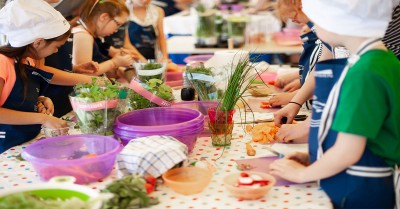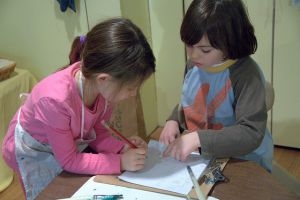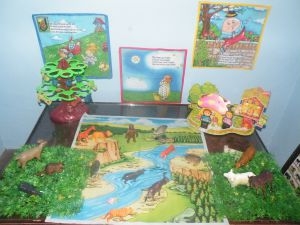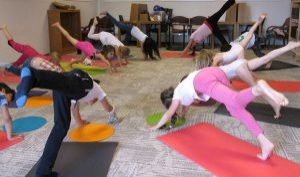The early childcare setting can be hugely valuable in instilling healthy eating and lifestyle habits in children. What better way to do that than by engaging them in fun cooking activities. The following article provides a list of cooking skills for children from 2 years to 5 years old.
For two-year-olds
Around the time children turn two, their hands and fingers will have greater control, which in turn helps to develop fine motor skills. Also with developing muscles, they are getting better at running around, picking things up and pushing objects. So when working in the kitchen, you can get your two-year-old learners to:
- scrub vegetables and fruits
- carry unbreakable items to the table
- wash and tear greens like lettuce and salad leaves
- break bread into pieces
For three-year-olds
By the time children turn three, they are more assured in their use of gross and fine motor skills. So they can usually wash and dry their hands, perform rotatory actions and hold tools with their fingers rather than their fist. They are now more interested in group or interactive play which is great for social activities like cooking. Also, their growing attention, verbal skills and improved ability to follow instructions means they can be roped into:
- pouring liquids into the batter after an adult has measured out ingredients
- mixing batter or other dry and wet ingredients together
- shaking a drink in a closed container
- spreading butter or other spreads
- kneading dough
- washing vegetables and fruits
- serving foods on the table
- placing things in the trash after cooking or after a meal
For four and five-year-olds
Children at this stage have improved fine motor skills and hand-eye coordination. As such they are able to pour without much spilling, and mash food besides using utensils and implements more effectively. All these abilities make four and five-year-old children ready to pitch in the kitchen by:
- juicing oranges, lemons, and limes
- peeling fruits like bananas and even vegetables like onions
- mashing soft fruits and vegetables
- scrubbing vegetables that can be easily held by the fingers like potatoes and mushrooms
- using a plastic knife to cut soft foods like mushrooms or hard-boiled eggs
- cracking and breaking open eggs and beating eggs with an egg beater
Also at four and five years, children’s cognitive skills are getting stronger, which means they are now ready to count, measure and note differences in shapes, sizes and textures. Also, they are getting better at cooperating with peers and following multi-step commands. As such children at this age can help in the cooking or baking process by
- stirring dry and wet ingredients together
- pressing cookie cutters into cookie dough
- measuring dry ingredients
- setting the table to eat with friends
- wiping up after cooking n clearing the table after a meal
Such age-appropriate cooking skills not just make for exciting lessons in the classroom, but also inspire children to eat healthy food at home and sustain healthy lifestyles in the years to come.
Tips For Engaging Children In Cooking
- Create a fun and nurturing environment where children have many opportunities to see, touch, smell, and taste the fruits and vegetables they have grown in the garden.
- Focus on seasonal fruits and vegetables being harvested from the garden, those available locally in season, or both.
- Model tasting new foods. Children are likely to follow an adult example.
- Encourage children to taste the raw product first, then to taste the cooked product, reminding children that it may take multiple tastings to get used to new foods.
- Encourage young children to say “no thank you” when they do not like a new food, rather than “yucky” or another negative word. “Don’t yuck my yum!”
- Supplement harvest from the garden with items from the local farmers market when there is not enough for everyone to enjoy from the on-site garden.
- Make enthusiastic and positive comments about the taste and texture of the new food.
- Compliment and thank children for their care and attention in preparing the delicious food items.
- Lead a positive discussion about the food, including its taste, texture, smell, and colour.
- Discuss how the food was prepared. Ask the children about the ingredients, the recipe, the steps taken, and the utensils used.
- Discuss appropriate serving sizes, which are smaller than for adults.
- Read children’s books that include cooking and gardening activities that can be referenced in the classroom
Further Reading
Cooking With Kids - Easy Vegetarian Recipes - Try out the following simple recipe that the children can help you with.
Growing An Edible Garden For Children - The following provides information on how to grow an edible garden.
Cooking Activities - A list of recipes that children can help with the cooking.
Reference:
Growing and Cooking Fruits and Vegetables With Children In Childcare, National learning Initiative







 Open ended questions cannot be responded to with one word answers such as yes or no. These types of questions enables a child to provide
Open ended questions cannot be responded to with one word answers such as yes or no. These types of questions enables a child to provide During your child’s preschool years, an important milestone begins to emerge. This is the development of pre-writing skills. Pre-writing skills are used to encourage, develop
During your child’s preschool years, an important milestone begins to emerge. This is the development of pre-writing skills. Pre-writing skills are used to encourage, develop Open ended materials enables children to play freely. They are objects that have no rules to follow, use or function. Raw materials that can be
Open ended materials enables children to play freely. They are objects that have no rules to follow, use or function. Raw materials that can be An Acknowledgment of the Country is a way of showing respect for the Traditional Owners and can be given by both non-Indigenous people and Aboriginal
An Acknowledgment of the Country is a way of showing respect for the Traditional Owners and can be given by both non-Indigenous people and Aboriginal Language plays an important role in a child’s development. It enables a child to communicate effectively with their family, learn at school, socialize with friends,
Language plays an important role in a child’s development. It enables a child to communicate effectively with their family, learn at school, socialize with friends, Like adults, children have to deal with their own stress in life. Moving house, starting a new school, preparing for a new sibling - these are
Like adults, children have to deal with their own stress in life. Moving house, starting a new school, preparing for a new sibling - these are Playdough is such a versatile material. It provides numerous benefits to children as they manipulate it, it is safe and soothing and provides children with
Playdough is such a versatile material. It provides numerous benefits to children as they manipulate it, it is safe and soothing and provides children with Teaching children about sustainability enables them to appreciate and respect the natural environment. Early childhood services can provide meaningful hand on learning experiences in order
Teaching children about sustainability enables them to appreciate and respect the natural environment. Early childhood services can provide meaningful hand on learning experiences in order Recycling is an important concept that teaches children to care for the environment. It encourages children to be responsible and show a growing appreciating for
Recycling is an important concept that teaches children to care for the environment. It encourages children to be responsible and show a growing appreciating for When children apply paint to paper, glue things together, or pound a lump of clay, they experiment with colour, shape design and texture.
When children apply paint to paper, glue things together, or pound a lump of clay, they experiment with colour, shape design and texture.



